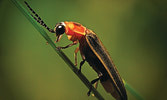By Rhea Hamilton-Seeger
The first full summer we were in our new garden, I saw a couple of fireflies. I was stunned. With all the streetlights, and new brilliant lighting systems on so many houses, it was a miracle that one would see a wee flashing firefly! We used to see fireflies in quiet areas of the farm but no matter where you see them it is such a magical moment.
So enjoying fireflies can happen away from cottage country and I went digging to find out how we could help make this happen more often.
The more I read about fireflies the more I thought about how their survival fits into the same movement to preserve our native bees and butterflies. Nothing in nature works in isolation. Everything has a purpose. Fireflies are more than a spark in the night. Like the bees and the butterflies, all insects have a role to play in pollinating and/or controlling populations of other insects.
I hope you are familiar with the term integrated pest management? The first step is to identify an insect problem in your garden (or farmland) then you take steps to reduce it. So let’s flip that thinking around. Let’s look at insect management; identify what insect you want to see in your garden, identify the habitat that would draw it and try to create it. I believe we need to learn how to identify fireflies by more than their spark, understand their life cycle, discover all the good they can do and encourage them to become a part of our gardens.
Fireflies, also known as lightning bugs, are classified as Lampyridae, members of the larger click beetle group that have elongated, hard shelled bodies and are generally plant eating. This family of beetles has their heads shielded by what would look like an elongated hood. A pair of hard coverings also protect their wings and are raised like gull wing car doors to expose and allow the true wings to spread. Surprisingly there are over 170 species in North America and an estimated 2,000-plus worldwide! (Firefly Conservation and Research, firefly.org)
We have always thought the bioluminescent signal was to draw partners but new evidence suggests it might be a warning signal. (Jesse Barber, a biologist at Boise State University, USA). Fireflies have developed a steroid to make them distasteful, and sometimes poisonous to some predators. Coupled with its distinct flight pattern and warning flashes fireflies have a protective system much like the colourful markings the monarch uses to warn predators away from its distasteful body.
Aside from the magical flashing, why would we encourage fireflies in our gardens? The firefly larvae feed on mosquito larvae, worms, slugs and snails; creatures we deal with in our gardens. These larvae spend up to two years in this stage before morphing into the adult stage. They too have the bioluminescence in their abdomens. Once they become adults some may eat pollen but the majority only live long enough to mate and lay eggs. They are active during the summer months for a few short weeks.
Firefly larvae require a damp-to-wet habitat which is why they are often seen along riversides and lakeshore areas where people vacation. But once those areas are over-developed with the building of more cottages or campsites, the creation of lawns and the increase in outdoor lighting, habitat is reduced or eliminated. We lived along the Saratoga Swamp in West Wawanosh and now in Goderich. Sightings along the swamp made sense but in Goderich I think irrigating systems, and being located in a wetter end of town, and of course leaves along the lake bank might all contribute to seeing fireflies here.
Gardeners are fast catching on to the importance of their yards to the natural environment. We can help restore habitat for so many fellow creatures one yard at a time. A lot of the work involves no work; learning to resist the urge to remove and tidy up our yards. You don’t have to give up on your lawns or that manicured look it if makes you happy, but you could set a back corner aside for simply letting nature take its course.
Don’t rake your leaves to the curb or remove them from the property. Pile them up and keep them moist, not wet, for three to six months of the year. This creates ideal habitat for snails and slugs, food for firefly larvae. Female fireflies lay their eggs in many spots but will obviously target moist areas where food will be guaranteed for their offspring.
To improve poor soil, work in some bag compost, leaves or other organic matter. Disturb the soil as little as possible by using a no-till method or a broad fork to simply loosen the soil by adding some holes.
Avoid chemicals and that includes fertilizers and any chemical pest controls you employ elsewhere in the yard. We also know that native trees and grasses help retain valuable moisture in the soil. Something more to think about
I found several wonderful websites but the best was by Firefly Conservation and Research or their website www.firefly.org. As well as wonderful educational information, they have a program to help guide individuals and organizations in creating firefly habitat. Once that is established there is a sign you can display educating others. ◊


